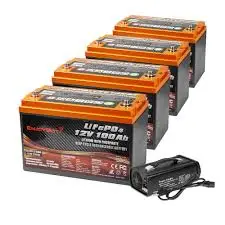Why mobility scooter battery draining fast?
April 14, 2018

In the world of electrical systems, combining many batteries to get the required power level is frequently necessary to create a higher voltage output. Connecting four 12V batteries to provide a 48V power supply is one typical case. Knowing how to connect these batteries correctly is essential whether you're working on renewable energy projects, recharging an electric car, or improving an off-grid solar system.
Connect the four12V batteriesin series to form a 48V power supply. Connect the first battery's positive terminal to the second battery's negative terminal first. Attach the third battery's positive terminal to the fourth battery's negative terminal to complete this series connection. The output voltage in this setup is 48V.
We will examine the procedures and factors to be taken into account when joining four 12V batteries to create a 48V power bank in this thorough tutorial.
Knowing the Fundamentals
Understanding the basics of voltage, current, and battery arrangement is crucial before starting the process of connecting batteries. The force responsible for the electric current's flow is voltage. The voltages of batteries connected in series add up. In contrast, parallel battery connections maintain voltage while increasing total current capacity.
Parallel vs. Series Connection
Connection in Series
Increasing voltage requires connecting batteries in series.
While voltage increases, capacity doesn't change.
One battery's positive terminal is connected to the subsequent battery's negative terminal.
Although a series connection raises the overall voltage, it has no effect on capacity.
In parallel Join batteries in parallel to boost their combined capacity.
Constant voltage is maintained while capacity grows.
Both positive and negative terminals are connected to one another.
While a parallel connection increases total capacity, it does not increase voltage.
Detailed Instructions for Joining Four 12V Batteries to Create 48V
Let's now explore how to link four 12V batteries in series to build a 48V power system step-by-step.
Gather the Materials
Ensure you have the necessary materials before starting the connection process:
Four identical 12-volt batteries with the same capacity.
Heavy-duty wires or cables that link batteries.
tape that insulates.
A battery terminal wrench.
Verify Details of the Battery
Verify that the voltage and capacity of all four batteries are the same (12V). Combining batteries of varying specs might result in inconsistent charging and discharging, which shortens the battery bank's lifespan and overall efficiency.
Recognize the Battery Terminals
Positive (+) and negative (-) terminals are present on every battery. To prevent confusion when connecting the batteries, become familiar with their arrangement and designate the terminals properly.
Select an Appropriate Site
Choose a dry, well-ventilated area to install your battery bank. Make sure there is sufficient room for all four batteries and that maintenance can be readily done in this easily accessible place.
Battery connections should be made in series.
To connect the batteries in series, take the following actions:
Utilising a battery connection cable or heavy-duty wire, connect the positive terminal of the first battery to the negative terminal of the second battery.
Connect the positive terminal of the second battery to the negative terminal of the third battery to complete this series connection.
Proceed by attaching the third battery's positive connection to the fourth battery's negative terminal.
When the last connection is made, the fourth battery's positive terminal will serve as the 48V system's positive output.
Safe Networks
Use heat shrink tubing or insulating tape to seal the connections after the batteries are linked in series. This guarantees the stability of the overall configuration and helps prevent unintentional short circuits.
Check the voltage.
Measure the voltage across the first battery's positive terminal and the fourth battery's negative terminal with a multimeter before adding the battery bank to your electrical system. A reading of roughly 48V indicates that the series connection was successful.
Adapt to Your System
After obtaining a 48V battery bank, incorporate it into the intended electrical setup. This can entail attaching it to a charge controller in a solar power system or an inverter for AC power conversion.
Considerations and Tips
1. Battery Upkeep
Keep an eye out for any abnormalities or wear and corrosion on the battery bank on a regular basis. Establish a timetable for maintenance to guarantee the batteries stay in top shape and increase their lifespan and efficiency.
2. The BMS, or battery management system
You should think about adding a Battery Management System (BMS) to your configuration. By keeping an eye on each cell's voltage, temperature, and charge level throughout the cell, a BMS assists in managing and safeguarding the batteries.
3. Safety Measures
During the installation process, handle batteries carefully and wear the proper protective gear, such as gloves and safety glasses. Before providing electricity, make sure all connections are secure and exercise caution to prevent short circuits.
4. Review the Instructions from the Manufacturer
Consult the instructions and specs provided by the manufacturer for the batteries that you are using. There may be specific requirements for different types of batteries; following these rules guarantees both safety and best performance.
In summary
Combining four 12V batteries in line to create a 48V power system is a workable way to satisfy greater voltage needs in a variety of applications. This detailed guide offers a step-by-step breakdown of the entire process, from material acquisition to battery bank integration with your electrical system. Always put safety first, follow manufacturer instructions, and do routine maintenance to make sure your battery system lasts a long time and functions well. By carefully planning and paying close attention to details, you can confidently construct a strong 48V power system that meets your unique requirements.
Comments
Write a comment